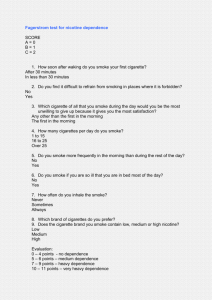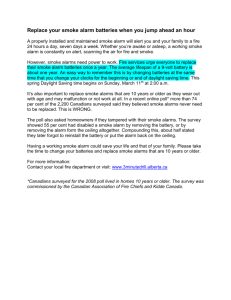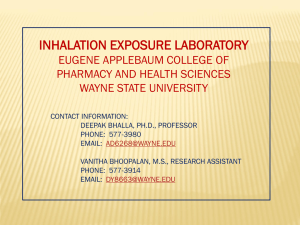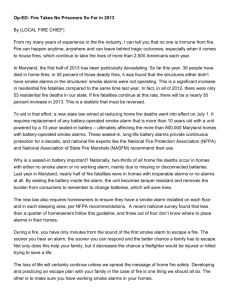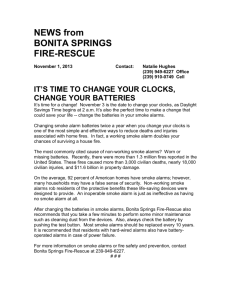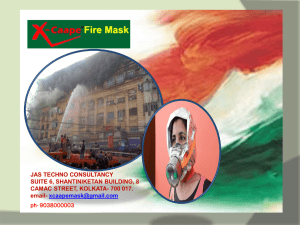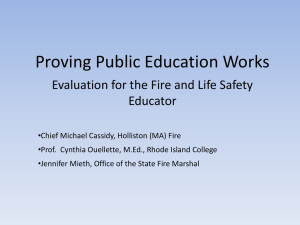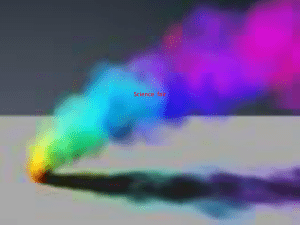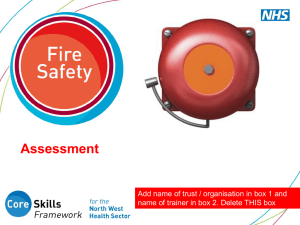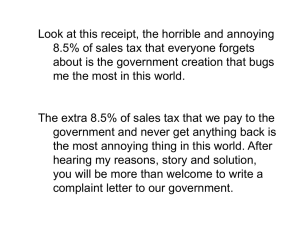Georgia Fire Prevention
advertisement
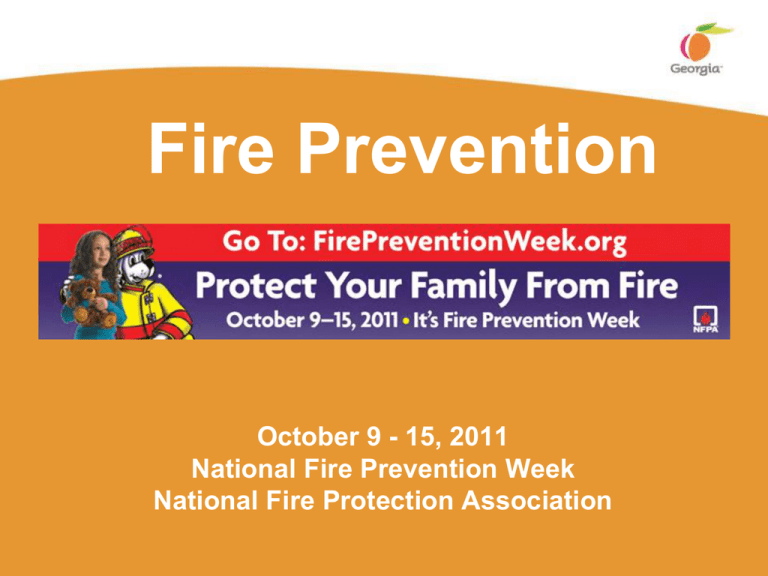
Fire Prevention October 9 - 15, 2011 National Fire Prevention Week National Fire Protection Association “Protect Your Family from Fire” 2011 NFPA Fire Prevention Week Theme Smoke Detectors: Two Basic Types Photoelectric Smoke particles encounter light beam. Beam scatters to a photocell creating a current. Better for larger particles (smoldering). Ionization Particles attach to ionized particles creating a detectable change in current. Better for smaller particles (flaming). Page 2 Presentation name | date Smoke Detectors • Brief history ▪ 1930s, Swiss scientist Walter Jaeger tried to invent a poison gas detector thinking the particles would interact with an ion gas causing a detectable change in current. The idea failed. Frustrated, he lit a cigarette and voila, the smoke detector. Page 3 Presentation name | date Smoke Detector Maintenance • Test your smoke alarms once a month. • Replace your batteries in your smoke alarm twice a year. • Hint: schedule battery replacements for the same day you change your clocks for daylight savings time. • Never “borrow” a battery from a smoke alarm. • Don’t disable smoke alarms even temporarily. • Regularly vacuuming or dusting your smoke alarm can keep them working properly. • Replace battery powered units every ten years. Page 4 Presentation name | date Common Fire Hazards Fire is the most common business hazard. • Are you prepared to fight a small fire? • Should you evacuate with every fire? • Have you performed a Fire Risk Assessment? Page 5 Presentation name | date Home Sprinklers & Smoke Alarms Interesting Statistic Sprinklers and smoke alarms together cut your risk of dying in a home fire 82%, relative to having neither, a savings of thousands of lives a year. + = Page 6 82% Presentation name | date Fight or Flee? • Will you fight a fire? • Before you do: ▪ Understand the uses; and ▪ Understand the limitations of a portable fire extinguisher. • Sound Evacuation Alarm First! Page 7 Presentation name | date If the evacuation alarm sounds • Go to your closest exit. • If smoke is at the primary exit, use your second way out. • When exiting through smoke, get low and go under the smoke to your exit. • Don’t go back for belongings. • Get out and help others get out. • Call the fire department from a safe location. • Go to your meeting area outside. • A management representative should meet the fire department to communicate that everyone is out of the building. Page 8 Presentation name | date Evacuation Plans and Procedures • Know your evacuation routes. • Know your meeting point. • Are you assisting someone on your floor? Page 9 Presentation name | date Fire Risk Assessment Prior to fighting any fire with a portable fire extinguisher, answer these questions: • How big is the fire? • Are there evacuation routes behind you? • What is the atmosphere like in the vicinity of the fire? Page 10 Presentation name | date Chemistry of fire For fire to exist, the following four elements must be present: • Enough oxygen to sustain combustion; • Enough heat to raise the material to its ignition temperature; fuel or combustible material; and • A continuous chemical reaction is required to sustain • Some sort of a fire. Take away any of these and the fire will be extinguished. Page 11 Presentation name | date Classes of Fire • Class A • wood, cloth, paper, cardboard • Class B • flammable or combustible liquids, gases • Class C • energized electrical equipment • Class D • combustible metal, chemical reaction • Class K • vegetable oils, animal oils, or fats Page 12 Presentation name | date P-A-S-S • • • • P A S S Pull the pin. Aim at the base of the fire. Squeeze the handle. Sweep side-to-side at the base of the fire. Aim Page 13 Presentation name | date Important! Use of a fire extinguisher is VOLUNTARY! Make sure you can get out before committing to using a Fire Extinguisher! Page 14 Presentation name | date Smoke Safely • If alcohol or medication makes you drowsy, or you’re just plain tired, put your cigarette out right away. • Never smoke in bed. • Use deep ashtrays and put your cigarette all the way out. • Don’t walk away from a lit cigarette. • Better Yet: Quit Smoking! Page 15 Presentation name | date Cook Safely • Never leave cooking unattended. A serious fire can start in just seconds. • Always wear short or tight-fitting sleeves when you cook. Keep towels, pot holders and curtains away from flames. • Never use the range or oven to heat your home. • Double-check the kitchen before you go to bed or leave the house. • Have a “K” type fire extinguisher available. Page 16 Presentation name | date Heat Your Home Safely • Space heaters need space. Keep heaters at least three feet away from your bed, curtains, and flammable materials. • When buying a space heater, look for a control feature that automatically shuts off the power if the heater falls over. • Keep fire in the fireplace by making sure you have a screen large enough to catch flying sparks and rolling logs. Page 17 Presentation name | date If you are on fire remember to… STOP, DROP, ROLL Don’t use Dry Chemical extinguishers! Don’t flap or slap at the burning clothes. React rapidly/urgently but stay calm. Don’t become a victim yourself. Use fire blankets when available. Page 18 Presentation name | date QUIZ! NFPA has prepared the following Safety quiz for Fifth & Sixth graders. See if you are smarter than a fifth grader! Page 19 Presentation name | date ANSWERS Page 20 Presentation name | date Contact Information C. G. Lawrence, III, CSP, REM, ARM-P Chief Loss Control & Safety Officer (404) 657-4457 Charles.Lawrence@doas.ga.gov Ted Low, Jr., CSP Chief Loss Control & Safety Officer (404) 463-6309 Ted.Low@doas.ga.gov

